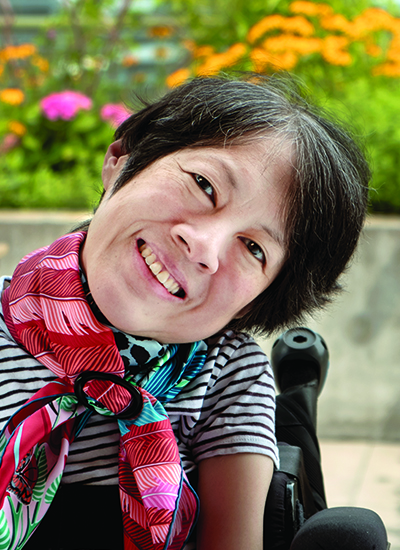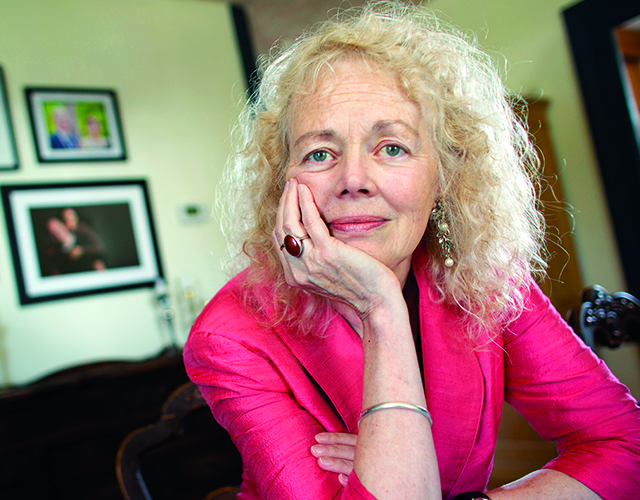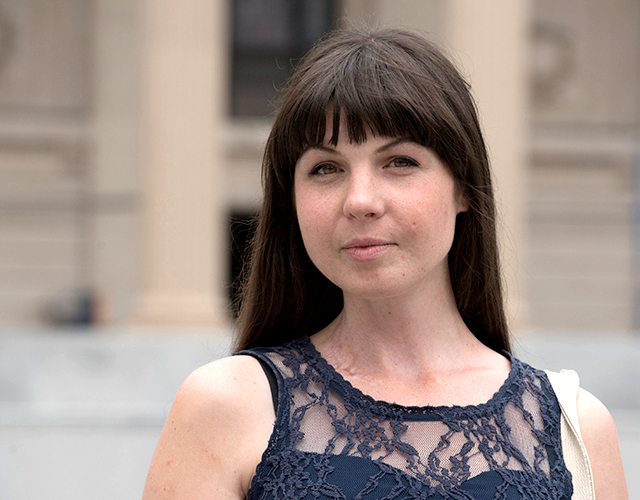Palliative care in Canada inconsistent, patients say
Palliative care is an essential aspect of health care for patients facing life-limiting illnesses. Unfortunately, many people face barriers to accessing palliative care. The following patient stories provide insights into these challenges and their impact on quality of life. To see the most recent CIHI data on palliative care, please go to our Access to palliative care in Canada page.

Ing Wong-Ward, who is currently in palliative care due to colon cancer, says this type of care has helped improve her quality of life.
September 2018 — It was a heartbreaking day last autumn when Ing Wong-Ward received the news she was dreading: her colon cancer was inoperable and no treatment options were available.
“I’m 45 years old; I thought what I had was 30 years of life ahead of me,” Wong-Ward said. “I have a young child to raise, I had a new career — it’s just not what anyone wants at this stage of life.”
Wong-Ward’s prognosis doesn’t mean her death is imminent, though. She and her family have time to prepare, to focus on the quality of the rest of her life and to plan for the end.
A key part of this process is palliative care, something she admits she knew little about prior to last fall.
“I think I knew as much as most Canadians,” said Wong-Ward, a former journalist at the Canadian Broadcasting Corporation. “I associated palliative with ‘you’re about to die.’ I really feel palliative care has become synonymous with that.”
This common misconception about the term is just one of the reasons the Canadian Institute for Health Information decided to report on this topic. The purpose of Access to Palliative Care in Canada is to help provide detailed information on what we know about palliative care services, on whether people in Canada have equitable and timely access to the right services in the community, and on information and service gaps in this area of health care.
After meeting with her palliative doctor at Mount Sinai Hospital in Toronto, Wong-Ward learned more about how this type of care addresses the needs of people with life-limiting conditions to improve their quality of life and that of their families.
“I was really surprised by how comforting it was,” she said. “Suddenly it felt like we were in control again. For so long, we were lurching from one crisis to another. It was like this rollercoaster ride, and suddenly I was in this office with this person who spent an hour listening to what I wanted, what my goals were, where I was at, and she basically indicated that her job was to shepherd me through what is the most difficult period of my life. It was, in the end, really reassuring.”
While stories like Wong-Ward’s offer a hopeful view of our country’s palliative care system, some Canadians’ experiences aren’t as positive.

Anya Humphrey, who lost her husband, Fred, and son, Ted, to cancer, says she thinks they could have greatly benefited from having palliative care as well as treatment.
September 2018 — Anya Humphrey of Campden, Ontario, has had 2 encounters with palliative care in Canada, as she has lost both her husband, Fred, and son, Ted, to cancer.
Humphrey said nobody ever discussed palliative care with her and her husband of 43 years until his treatment options were exhausted.
“We were completely cut loose,” she said. “We had not gotten a palliative care team on board, we weren’t going to see anyone that we’ve known — we just had nothing.”
Humphrey said that Fred, who was a high school English and photography teacher and a volunteer firefighter in his community, eventually got some palliative care at home in the last weeks of his life, but she feels it was too little and far too late.
“Palliative care is everybody’s right. That’s how I see it,” Humphrey said. “We don’t expect women to give birth all by themselves, with no help, and I don’t think society expects people to die by themselves either.”
The absence of support at her husband’s death still troubles Humphrey.
“It was awful and much more awful than it had to be,” she said. “If there had simply been someone there in my house...”
Humphrey’s son, Ted, was diagnosed with testicular cancer about one year after his father’s death.
“He went through hell with chemo,” Humphrey said. “It was just a nightmare.”
And through his whole illness, even though his cancer spread to a dozen different parts of his body, Ted never received palliative care before dying unexpectedly at his mother’s home.
“Nobody ever talked about palliative care with Ted because they really didn’t think he was going to die [from the cancer],” Humphrey said.

Bronwen Garand-Sheridan received palliative care in her early 20s while she battled lymphoma but says the system is not designed to address the needs of younger people.
September 2018 — Bronwen Garand-Sheridan was in her early 20s and an accomplished oboe player who had been playing regularly with the Winnipeg Symphony Orchestra when she was diagnosed with lymphoma.
While her cancer has been in remission for many years after having undergone a stem cell transplant, Garand-Sheridan’s prognosis was not good when doctors initially learned that her chemo was ineffective.
“My odds went from an 80% chance of survival to a 20% chance,” Garand-Sheridan said.
Her health continued to deteriorate as she underwent more and more treatments, and when her options grew more limited, she was told she had only days left to live.
“To have access to palliative care, I had to agree to a do-not-resuscitate order,” Garand-Sheridan said. “I remember everything about that moment. It was terrifying for me.
“My parents kept saying ‘this is so you can have access to palliative care’… but I still had no idea what palliative care meant.”
Her palliative care team encouraged her to move into a hospice, but Garand-Sheridan was concerned that the facility was not a good fit to deal with the needs of a younger person, so she fought to remain in her apartment.
“Any quality of life I had at home seemed like it would be taken away by this hospice situation,” she said.
Garand-Sheridan credited her doctor and primary care nurse for going the extra mile to try to provide her with the type of palliative care she needed.
“I know I had more age-appropriate care than most because of those 2 people, but it also shows the holes in the system — it takes people going out of their way and above and beyond their already stressful jobs to provide something that’s even close to adequate care,” she said.
Garand-Sheridan is now 33 years old, has a 7-year-old son and is attending Yale University, pursuing a PhD in music theory. However, her experiences have left her with clear thoughts about what could be done to improve the palliative care system in Canada.
“I strongly believe that palliative care should be available at diagnosis to help with everything from coping with a fear of death to preparing for end of life,” she said. “My experience was extremely hard because of the lack of knowledge in the system of what my needs were as a young adult.”
Few Canadian doctors specialize in providing palliative care. In 2015, just 30% of medical students completed clinical rotations in such care, and these rotations were mandatory in only 2 of Canada’s 17 medical schools.
“The need for primary care doctors to feel prepared to manage this is key, because patients can start palliative care during active treatment,” said Dr. Pippa Hawley, head of the Division of Palliative Care at the University of British Columbia. “Ideally,” Hawley said, “palliative care should begin alongside curative treatments soon after the diagnosis of a condition that may be life-limiting.”
This likely reflects palliative care’s origins as a treatment approach for cancer patients. However it has long been recognized that palliative care is beneficial to people with other conditions as well, including heart failure, lung disease, renal failure, dementia and other neurodegenerative diseases.
Surveys show that most Canadians (75%) would prefer to die at home, with the right supports in place. Early palliative care in the community is also associated with better outcomes for patients at the end of life: those who received palliative care prior to the last month of life had fewer unplanned emergency department visits and intensive care stays.
“From what I see, at this point, the system is simply not ready to give adequate support to everybody who wants to die at home,” Humphrey said. “Until the system is prepared to give dependable, adequate support, I will not choose to die at home. I don’t want to die without symptom control, and I don’t want my family to have to face potentially traumatic circumstances all by themselves.”
Wong-Ward says she’s grateful to be getting early palliative care and hopes that more people can benefit from the types of services she is receiving in the community.
Featured material

Access to Palliative Care in Canada, 2023
This report presents the latest data on access to palliative care in Canada, and contextual information on caregiver and provider experiences.
Related resources
Contact
How to cite:
Canadian Institute for Health Information. Palliative care in Canada inconsistent, patients say. Accessed April 24, 2025.
If you would like CIHI information in a different format, visit our Accessibility page.

